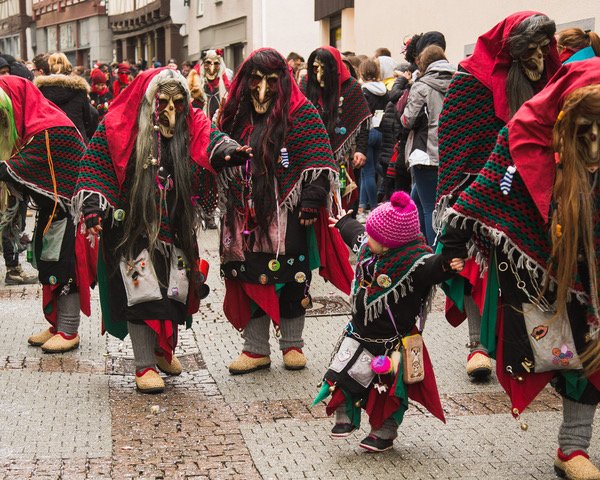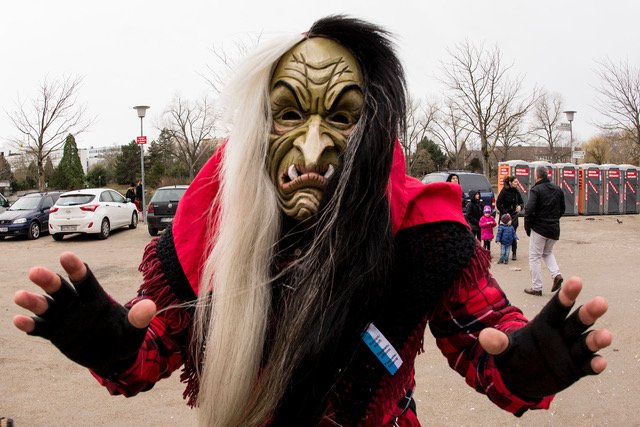
By USAG Stuttgart Public Affairs
Fasching season officially began Jan. 7 … sort of. In 2020, Fasching will be celebrated from Feb.20 to Feb. 25 with fests, parades, music and many “foolish” events. This year, most street parades will take place between Feb. 22 and Feb 25. However, in some areas of Germany, Fasching guilds commemorated the beginning of Fasnet, as it’s known in Swabia, at the exact same time and day as when the silencing of the guns of the Great War is commemorated: 11:11 a.m., Nov. 11. with local and ceremonial events that prepared for the official start of the foolish season in January.
During the various Fasching parades in Southern Germany, Narren, or Fasching fools, will be seen with wooden masks in the images of witches, devils and grotesque animals. In Swabia and Southern Germany, the costumes are called “Häs.” Be on the lookout for Narren, who will walk up to you and either ruffle your hair, paint your face, take away a hair band or drop you a piece of candy.
This slideshow from the 2019 Neuhausen Fasching Parade is by Stuttgart military community member Brian Cann:
[slideshow_deploy id=’48779′]
Fasching dates back to 1200, being a way for citizens to live it up in the week before 40 days of Lent. It’s a time to be foolish, silly or wild, as evidenced by the costumes and events, such as Weiberfasching on Feb. 20, the day when women have the right to freely cut off men’s ties with scissors and kiss any man they wish to during the day. It’s also an opportunity for women to enjoy a girl’s night out and symbolically take control for a day.
Expect to see special Fasching doughnuts called Fasnetsküchle or Krapfen, as well as other tasty, greasy foods during the traditional Fasching week, starting on Schmotziger Donnerstag, or Greasy Thursday. The Swabian word schmotzig means lard or grease and refers to the opulent food eaten during Fasching. The remainder of the Fasching week is Fasching Saturday and Sunday, Rose Monday and Fat Tuesday.
On the evening of Fat Tuesday, the Fastnacht, represented as a witch in southern Germany, is buried in a casket and the wild days end at midnight.
This slideshow by former USAG Stuttgart Public Affairs team member Kevin Abel is from the 2019 Sindelfingen parade:
[slideshow_deploy id=’48780′]
At 12:30 p.m., Feb 23, the Kübelesmarkt Fasching guild hosts a huge Narrenumzug, or Fasching fools, parade on Sunday, starting at Neckartalstrasse alongside the Neckar river over the Wilhelms-bridge directly onto the pedestrians’ zone, and throughout the historic old city of Bad Cannstatt featuring over 71 Faschings guilds.
Neuhausen celebrates Schmotziger Donnerstag at Schlossplatz with the Hexentanz, or witch’s dance, 7 p.m., Feb. 20. During the event, Neuhausen’s Fasching fools storm the town hall and force the mayor to hand over the keys to the city. Celebrating this symbolic event, a huge fire is lit. Neuhausen’s parade takes place at 1:30 p.m., Sunday, Feb 23.
(Editor’s note: Teresa Weiss, Carola Meusel, Angelika Aguilar and John Reese contributed to this article.)
Fasching Parades and other events
- Böblingen: Feb. 24, 1 p.m.
• Rottenburg am Neckar: Feb 20, 1:30 p.m.
• Neuhausen: Feb. 23, 1:30 p.m.
• Weil der Stadt: Feb. 23, 2 p.m.
• Hechingen: Feb. 25, 1:30 p.m.
• Rottweil: “Narrensprung” (fool’s jump) Feb. 24 at 8 a.m.; and Feb 25 at 8 a.m. and 2 p.m.
• Stuttgart: Feb. 25, 2 p.m.
• Hofen: Feb. 25, 1 p.m. Entrance fee: E 2.50 - Bad Cannstatt: “Närrischer Wochenmarkt” (weekly market with Fasching entertainment and music), Feb. 20, 10 a.m. to 1 p.m. at Marktplatz.
• Bad Cannstatt: “Rathaussturm,” Fasching fools storm the historic town hall, Feb. 20, 6 p.m.; on Feb. 20 (“Schmotziger Donnerstag”), various restaurants and bars in downtown Bad Cannstatt offer music and Fasching parties until 2 a.m.).
• Bad Cannstatt: Närrisches Tribunal (Fasching Fools’ Tribunal) / Schnurren Schnitzelbänk on Marktplatz in Stuttgart and Bad Cannstatt, Feb. 24, 5:45 p.m. - Bad Cannstatt: Geizigrufen at Marktstrasse, Feb. 25 at noon, followed by a children’s parade at 2:30 p.m. through the downtown area. The procession to end Fasching time will start at 11:45 p.m. with Fasching fools taking the straw puppet symbolizing Fasching from Marktstrasse to Wilhelmsbrücke to burn and drown the puppet. This tradition is called verbrennsäuft in the Swabian dialect.

